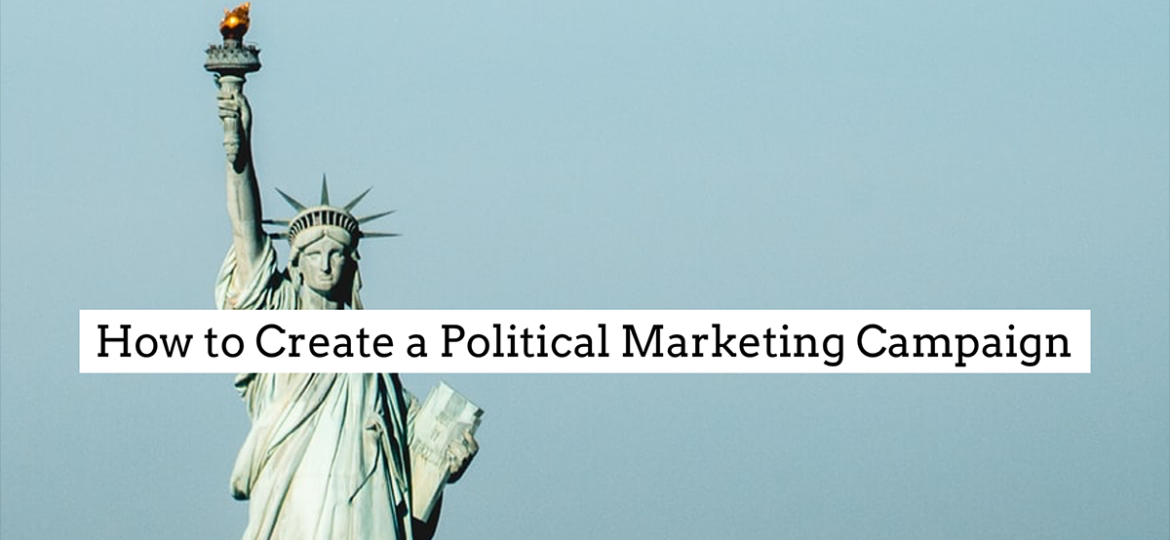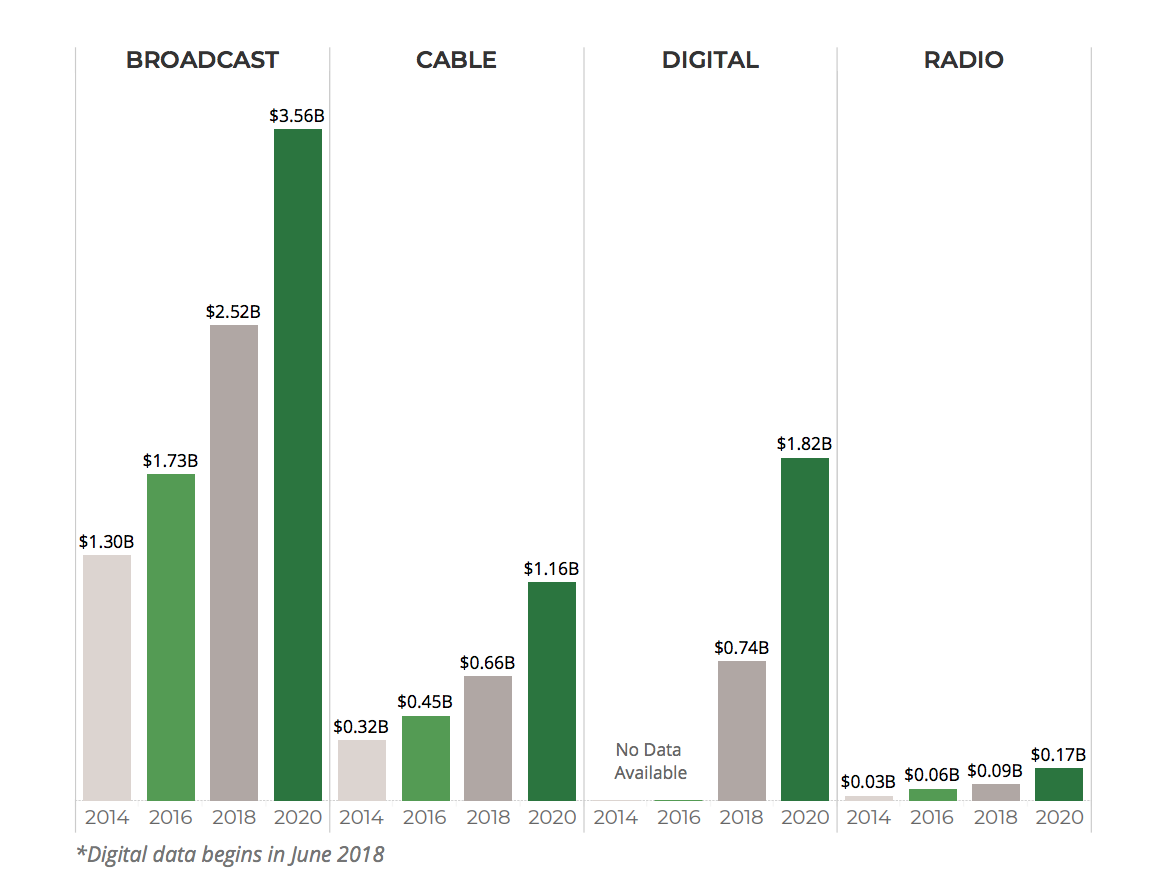
It’s no surprise that 2020 is predicted to smash all political spending records. In a seemingly divided nation, candidates in every state are doing their very best to convince you to give them your vote. We’re inundated with campaign messages at every turn: on the radio, on TV and online. And logically so—record-breaking fundraising and lack of face-to-face campaigning due to Covid-19 have driven up other areas of political budgets (i.e., digital video). Politico recently released a 2020 Political Spending Projections report in which they increased their initial $6 billion 2020 political spending estimate by 12% to $6.7 billion.
Regardless of product—or, in this case, office—there are certain characteristics that make for a good campaign. From student council to congress, we’ll share our top tips for creating a cohesive political marketing campaign.
But first—some facts!

TRADITIONAL ADVERTISING
Top-line projections by Advertising Analytics, along with Cross Screen Media, indicate that in 2020, political spending in traditional media will more than double political spending in digital media—particularly in broadcast TV. According to data from May of this year, $1.8 billion has been spent on digital video, while $4.9 billion has been spent on traditional media (broadcast television, cable and radio).

LOCAL
Accounting firm, Miller Kaplan, has provided an audited political spending report for the Tampa area. The report’s auditors estimate that in 2020, $78 million in political advertising will be spent on broadcast TV alone. This election year’s political ad spending will be driven almost exclusively by Donald Trump, Joe Biden, and PACs (political action committees). Most of the budget will be spent between September 1 and November 3.
Comparison chart for the three previous political cycles:

Politico and its research partners expect that 14 markets will exceed $100 million in revenue this year. Further, North Carolina and Florida will have two markets exceeding $100 million in revenue.

DIGITAL ADVERTISING
Although traditional advertising is, and will continue, leading the way in 2020 total political spending, candidates’ digital media budgets are nothing to scoff at.
Here are a few figures to put this year’s digital political spending in perspective:
- $400 million (67%) has been spent in direct response vs. $145 million in “persuasion” ads
- The Trump Campaign has spent $48 million on direct response ads (94% of their total spending)
- The Biden Campaign has spent $16 million on direct response ads (86% of their total spending)
- The Presidential General projection has increased from $1.8 billion to $2.2 billion, partially due to record-breaking fundraising
- Senate projections have increased 19% to $1 billion as of May 5, 2020; $196 million has been reserved by Senate advertisers for the fall
- Persuasion ads more closely resemble TV trends: more than 75% of spending generally happens in the 10 weeks leading up to election day

THE TRUST ISSUE
Here’s the thing, voters and consumers still trust TV. When it comes to social media and “the computer,” as many of our parents and grandparents refer to the Internet, two words are usually top of mind: FAKE NEWS. There’s also the issue of privacy—many of these people are still torn up about losing their life savings to a Nigerian Prince in the late 90s.
Jokes aside (for now), the dissemination of less-than-factual information and the invasion of personal privacy are real hazards in the digital space. Marc Pritchard, chief brand officer of Procter & Gamble, addressed this issue at the 2019 Association of National Advertisers’ (ANA) Conference:
Digital media continues to grow exponentially, and with it, a dark side persists. Waste continues to exist from lack of transparency and fraud. Privacy breaches and consumer data misuse keep occurring. Unacceptable content continues to be available and is still being viewed alongside our brands.
Like “the computer,” trust in a candidate is never a guarantee. By taking strategic steps toward authenticating oneself through deciphering several CAPTCHAs the proper channels, a candidate can effectively—and safely—reach the right voters.
OUR TOP 3 POLITICAL MARKETING CAMPAIGN TIPS
Remember, not all advertising campaigns are created equally. Best practices for a political marketing campaign look much different than for that of, say, an “athleisure wear” campaign. The political arena is a one-of-a-kind “business vertical” that comes with its own unique challenges. If you want your campaign to have any chance at all, you have to put in the work. And it’s a lot of work.
We’re here to help, even if it’s only to provide you with this information. You can also check out our blog post, 3 Brand Audit Basics for Small Businesses. Because, when you’re in politics, it’s your job to sell yourself and your ideas.
Discover our top 3 political marketing campaign tips:
DO YOUR RESEARCH
There’s little to nothing a brand can do that’s worse than not knowing its audience. (Remember the Kendall Jenner Pepsi commercial? Seems oddly prophetic now.) The same goes for any political candidate. Research is the backbone of any good campaign strategy.
And this doesn’t just mean researching likely or “sway-able” voters—demographic and socioeconomic information; ways in which they spend money; their direct influence over others in their circle; the list can go as deep as researchers have the time and budget for. And right now, most of us have a lot of time on our hands. Including those in and/or running for office.
This also means researching your competitors in relation to your brand. What are your strengths (potentially their weaknesses)? What are your weaknesses (potentially their strengths)? Where are your opportunities for growth within your competitor’s “market” (among their voters)? Who or what are your main threats? Answers to these questions form a SWOT analysis—a tried and true tool used by research and business professionals across specialties to gain high-level insight.
Research can be grueling, but as with almost anything in life, preparation is key. Considering running for public office? Check out this great resource from SpeakEasy Political to get you started.
BUILD YOUR BRAND CAREFULLY

Top-level goals:
- Create consistent, well-designed campaign assets: campaign logo, website, brochure/pamphlet, etc.
- Create unique content that conveys your overall message
- Engage your audience at several points of contact: social media, email, etc.
Every business card, every button, every billboard has to tell your story in a matter of moments. Who are you? What do you stand for? Can I trust you? You often have to convey these messages merely through color palette, font & typeface choices and headshots. Do you know what this means? You need to hire a professional to create brand guidelines for your campaign. You also need to get professional photos taken. Do not, I repeat, DO NOT try to DIY this unless you’re a damn good graphic designer, copywriter, web designer, web developer, photographer, media buyer, social media specialist and sign fabricator in addition to being an exemplary leader and politician. You may not believe it, but the general public makes HUGE decisions based on these things. People 100% judge a book by its cover.
Say you’re on the ballot with someone who didn’t make the wise choice that you did by hiring professional advertisers & marketers, and had his nephew—who’s “good at drawing” and does sick TikTok dances—create his branding and run his social media. Say a voter who doesn’t know much about either of you has to make a game-time decision. This voter remembers scrolling by one of your professionally created and targeted ads on Instagram and now sees your cleanly designed yard sign out in front of the polling place. The voter also sees a sign for your competitor—it’s pixelated and poorly designed. And uses Papyrus font (how dare you, fictitious candidate). The voter is going to have a better feeling about you, regardless of your politics.
MASTER YOUR MESSAGING
The goal of any political marketing campaign is to tell the candidate’s story. Budget will no doubt have an impact on the logistics, but if a candidate doesn’t have a story, s/he/they have nothing. Like Whitney Houston/”The Bodyguard”-nothing. Don’t make me close one more door.
Now that I’ve alienated half the readers who have no idea what I’m talking about, let me make my point: platforms and politics are important, but without a foundation of a human person to attach them to, voters will feel disconnected. Or worse, disengaged.
I understand that “engaged” is a bit of a buzzword these days, but it doesn’t take away from its importance in a political marketing campaign. Engagement is how candidates reach people. Whether it’s a town hall, an email or a Facebook Live video, voters need to know exactly who you are, exactly what you stand for, and most importantly, exactly how you plan on implementing your ideas that will improve their lives.
Your messaging needs to be clear, concise and easy-to-understand. Don’t pander. Don’t patronize. Just talk to people like they’re people, and show them why you’re the best candidate for the job.
And, as always, we recommend hiring professionals to help you out.
We’re in the midst of one of the toughest times we’ve ever had to face as a nation. It’s also an election year, which can be stressful enough on its own. With all the noise out there, it’s difficult to decipher what matters and what’s spam.
There’s a bit of truth to that old cliché: the only person you can trust is yourself. Of course you can trust your friends and family with certain things, but we’ve all had an aunt we’ve had to mute on social media because of politics. Regardless of which end of the ballot you’re on, we’re all voters (HOPEFULLY. If you’re not, here’s Florida’s online registration form. It’s easy! Exercise your voice!). We should all do our own research and come to our own conclusions. And it’s much easier to come to those conclusions if a candidate’s intentions are clear from the start.




